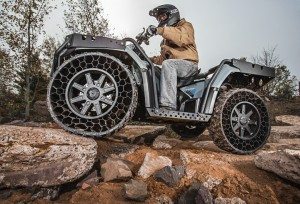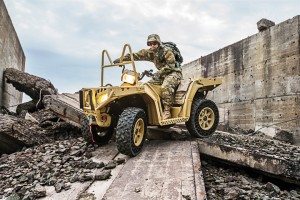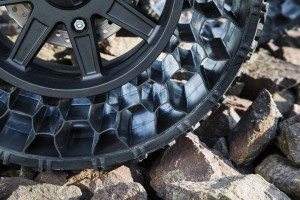Polaris is reinventing the wheel and the tire
Non-pneumatic tire to appear on ATVs and side-by-sides in 2014
When most people envision a tire, they picture a metal rim surrounded by a ring of rubber that’s inflated by air. But Polaris’ newest tire looks nothing like that. Instead, its most striking feature is the honeycomb ring, surrounded by a band of rubber that requires no air for use.
Like a few of Polaris’ products of late, the company came to develop its non-pneumatic tire (NPT) as the result of an acquisition. In April 2012, the OEM purchased Resilient Technologies, a Wisconsin-based company that had already produced an airless lawn mower tire and had worked with the U.S. Army on the development of airless Humvee tires. Merging of the companies, then, seemed like a smart fit as Polaris Defense had already developed off-road vehicles for the U.S. military and allied forces.
The Polaris NPT features a rubber tread band surrounding a polymetric web with a honeycomb design. With the suspended web, the tire works much like a suspension bridge, explained Tate Johnson, Polaris Defense operations manager, and Paul Dutch, site manager at Resilient Technologies.
“The tires are laterally stiff,” Johnson said in an interview with Powersports Business. “When I say laterally stiff, it’s similar to when you take a corner on a normal ATV or side-by-side, the tire kind of rolls; these are stiff, so they roll less, which has some handling benefit. They’re also really set up, so when you’re crawling over those nasty jagged rocks that tread band kind of forms to them. It gives you a really, really good grip or footprint grab over those obstacles, so you get the best of everything. You get a stiff tire like if you had a really, really highly inflated pneumatic, but you also get a tire that can crawl and grip over all kinds of different terrain. So it’s kind of a perfect fit for an off-road vehicle.”
No flat tire concerns
And the major benefit is the tire doesn’t go flat. Originally designed for the military, so troops can get in and out of a situation without worrying about getting a flat tire, the NPT has been tested in military and railroad settings with much success.
“We’ve shot these with 50-caliber bullets, and continue to drive them for 5,000-plus miles. You don’t have to look down; you just keep on going like nothing happened,” Johnson reported. “We’ve provided some of these to the railroad industry as part of testing, and they have multiple punctures in them from railroad spikes. They pull them out and just keep going. In a tactical environment, the war fighter … doesn’t have time when bullets are flying by to change a tire.”

Another benefit is that without concern for flats, neither the military, nor consumers, have to carry a spare, meaning there’s more space in the vehicles for food, supplies or another person, depending on where the spare was traditionally stored.
Though the tire won’t go flat from puncture, eventually the tread will wear, but Johnson points out that in the past, that has been a rarity in the ORV market.
“The good news is most ORV tires, they don’t ever wear the treads out because we have punctures and stuff well before we ever have to worry about tread wear,” he said. “So it is going to wear like any other tire; there is a wear element. But the good news is we get to worry about that instead of punctures at 50 miles.”
While the tire is only currently available for the military MV850 and WV850 and a limited number of consumer Sportsman WV850 H.O. ATVs released in December, more consumer applications are in the works.
“It will be offered as a standard option on a variety of ATVs and side-by-sides later this year,” Dutch said. “We’re going to offer the non-pneumatics on our side-by-sides, and that’s geared more toward the work environment at this point because we’ve had so much feedback on this coming from that community.”
While Polaris is looking forward to rolling out the tire on more of its lineup in the near future, the OEM and Resilient have found that each vehicle requires that the NPT be tuned differently, so different versions must be created, depending on the vehicles’ size and use.
“What we mean by tuning, it’s basically we’re balancing the geometry of the web with the material of the web and the physical properties of the tread band, the lug pattern, the material stiffness, so the tires perform in concert with the operation of the vehicle. We have to take things into consideration such as the weight of the vehicle, its capabilities, as well as the ease and the smoothness of the ride,” Dutch explained, adding that different iterations may have different tread patterns or different web material thickness.
Creating a smooth ride
Polaris has also had to factor in each vehicle’s composition before adding the tire to it. Switching a side-by-side or ATV from an air-filled pneumatic tire to an NPT isn’t as simple a pulling out a few lugs and installing the NPT.
“I can speak to this from experience. We thought, ‘Hey, let’s just bolt those things on; they’ll fit,’” Johnson said. “There’s a massive amount of interaction between suspension components, frame, driveline, steering and the tire itself, which we’ve learned as we’ve dug into this. That’s why it’s only been launched on two of our vehicles so far. You might physically be able to bolt it on and bolt it off, but if it’s not properly tuned and you don’t have the right integration from vehicle down through the tire, you’re not going to have the best experience.”
But, Dutch explains, altering the makeup of the vehicles wasn’t completely unexpected, considering that has happened when tires have changed in the past.
“I think a lot of people forget that when we went from a bias-based tire to steel belts and radials, there was a transition with the automakers. They had to do different things and upgrade their suspension for that vehicle to be able to work with that new technology. And we’re kind of going through that same process with it, so as we work through it, there will be more applications,” he said. “We want to make sure that we’re careful in putting it on the next application or the next platform. We want to make sure that it’s a good fit for both the driver and the machine.”
It’s likely that if dealers start carrying the NPTs on their shelves, they’ll be selling them with an entire suspension upgrade package, except when NPTs are being replaced on vehicles on which they came stock.

The NPTs are designed for most military and consumer uses as they can be tuned for everything from rock crawling to riding the dunes, and with the webbing pattern, they’re self-cleaning, as the honeycomb shape spins dirt out as it’s rolling. The only terrain the NPT isn’t currently designed for is thick mud or deep, soft sand, but those are both areas that Polaris is studying.
“ATVs are normally equipped with a tire that’s most capable of handling a broad range of environments, so just like we’re developing different size NPTs for future vehicle platforms, we’re also looking into developing multiple treads, and these could be precisely designed for different types of environments, like soft sand or mud,” Johnson said.
Potential new industries
As for consumers, Dutch expects those who need consistent reliability from their tires to be first on the bandwagon.
“I think the folks that we see as the early adopters coming on board initially are those that whether they have a Polaris vehicle for work, sport, or a combination of both, they want to keep moving. They don’t want to be stranded on the Back 40 or out on the trail in the middle of nowhere. That’s really what’s got them gravitating toward this technology,” he said.

As more news is released on the NPTs, and as Polaris launches it on more vehicles, the company has received a barrage of inquiries from other industries looking to take advantage of the technology.
“We’ve had a tremendous interest from folks in mining, turf, agriculture, construction and even the aviation communities, and we believe the applications for the non-pneumatic tires will eventually be part of numerous industries. And those are the same industries that incorporate standard pneumatic tires on their equipment or vehicles right now,” Dutch said. “So it’s identifying those groups, or having them identify the technology and how it works. I know the rail industry is extremely excited about it, simply because they’re working in an environment where they have rail spikes littered all over their yards. What they can do is save down time and save soft costs, and that translates to numerous other industries. We have a lot of folks asking us about it, and we’re developing them for different things.”
That interest, both from inside and outside the ORV world, is keeping the staff at Polaris and Resilient happy and busy.
“Everybody at Polaris is excited about it. The team here at Resilient is extremely excited about it. We enjoy coming into work every day,” Dutch said. “We like to joke that we are reinventing the wheel, and it keeps us motivated, it keeps us fired up, and we enjoy doing what we’re doing and integrating this technology into new platforms.”
Though Johnson admits that traditional pneumatic tires aren’t going to be completely replaced any time soon, it’s a sure bet that people should expect to see more honeycomb NPTs on the trail and at worksites in the near future.








